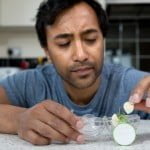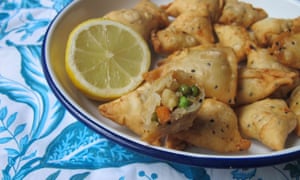
Samosas have been the victims of a grave injustice. Those deflated triangles of cardboard pastry sold in supermarket Indian snack selections bear as much resemblance to a flaky, freshly fried samosa as a Krispy Kreme does to a proper jam doughnut.
The first time I had the real thing, purchased through the bars of a train window on route from Delhi to Gorakhpur junction, was such a revelation that I scoffed the entire greasy bagful. As Simon Daley writes, “Once you’ve eaten homemade samosas, served fresh and crisp from a karai of crackling hot oil with a squeeze of lemon, you’ll never want to touch stodgy, greasy store-bought ones again.”
That first homemade samosa is plucked straight from Pandora’s box, however; with even many restaurants serving up substandard samosas from the freezer, one bite condemns you to a lifetime of making your own. Which isn’t the worst thing in the world, I suppose.
Pastry
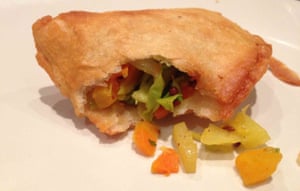
Samosas are traditionally made from a fairly sturdy pastry, presumably because, like the British pasty, this eminently portable snack was designed to travel well – they’re thought to have come to India from Central Asia in the saddlebags of Muslim merchants. Most people use plain flour, although Simon Daley, author of a book called Cooking with My Indian Mother-in-Law, makes his even more robust with strong white flour of the kind used for baking.
Madhur Jaffrey, Vivek Singh andRaghavan Iyer all work fat into the dough – the first two in the form of vegetable oil; the last, butter – while Daley relies on water alone to bring his pastry together, which makes his chewier than the others, though not unpleasantly so.
The butter version turns out more like a shortcrust than the crisp, flaky pastries produced by the oil, though this may also have something to do with the method: Iyer makes hers in the food processor, while Jaffrey and Singh gently rub the fat in by hand in the traditional way, which coats the proteins with fat while minimising gluten formation. It is then kneaded to partially develop the gluten, creating an elastic but still tender shell that is strong enough to withstand the pressures of stuffing and deep-frying, but soft enough to crumble obligingly in the mouth. With this end in mind, plain flour seems the better choice.
Despite Daley’s strict instructions to his readers to “Accept no substitutes!”,Meera Sodha’s book Made in India uses two layers of filo pastry, brushed with melted butter, for her “magic triangles”. This works surprisingly well, and is wonderfully quick though, as she observes, the results are lighter and crisper than the classic version.
Singh works nigella seeds into his pastry, which not only looks smart, but tastes delicious.
Stuffing
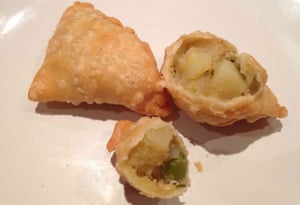
Samosas come in many forms, but, in a country where 20%-40% of the population is vegetarian, the meat-free version is the most popular. Potato tends to form the bulk of the filling, usually pre-cooked and mashed, though Daley sautes raw cubes until “tender but still retaining some bite”. This keeps all the ingredients separate, but I rather like the contrast between the fluffiness of the mash and the crisp pastry.
Everyone uses onion in some form (although not always cooked) and Sodha and Daley stick in some garlic, too. Peas are also popular, with Simon Hopkinson suggesting that if fresh aren’t in season, “I would prefer marrowfat peas” to the frozen variety, although they’re too mushily similar to the potato for my liking. Smaller peas add sweetness, too, as does Daley’s carrot and Sodha’s beetroot, all of which are a great counterpoint to the spice.
Along with carrot, potato, peas and two sorts of onion, Daley sticks in some shredded cabbage, which gives his filling a surprising lightness, as well as a pleasing variety my testers prefer to the stodginess of Jaffrey’s overwhelmingly potatoey one. Feel free to use whatever ingredients you have to hand, while aiming for a variety of textures and flavours; something soft, something crunchy, something sweet and something savoury – which, in Sodha and Singh’s cases, means cheese.
Sodha uses salty, crumbly feta, and Singh the much milder, creamier paneer, which feels the more authentic choice, although I’d recommend salting it first to add flavour. The chef also adds rich, crunchy cashew nuts, which, though rarely unwelcome, feel like overkill with the cheese, although if you’d prefer a vegan recipe, they’re an excellent alternative.
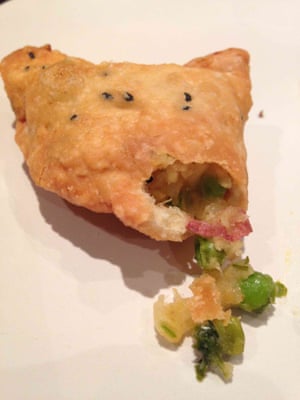
Spicing
However simple you choose to keep your filling, a touch of spice is non-negotiable. The sweet heat of ginger and chillies, as deployed by Jaffrey, Daley and Singh works well, as does the fresh aromatic flavour of the equally popular fresh coriander.
Daley employs the most complex spicing, using mustard seeds, fenugreek, asafoetida, curry leaves, turmeric and dried red pepper, plus his mother-in-law’s “secret ingredient”: a special masala used solely for samosas – “It was with some reluctance and a good deal or persuasion on my part that she eventually gave me the details.”
It has cinnamon, cloves, cumin and chilli to thank for its “distinctive scent and flavour”, which my testers can’t quite put their finger on – what they do know is that they like it. As most of the other recipes use garam masala, which tends to contain some of the same ingredients, along with extra chilli and cumin, I don’t think my recipe requires much else, and certainly not the sugar that Daley and Singh also stir in. A finishing squeeze of lemon juice, however, rounds things off nicely.
Folding
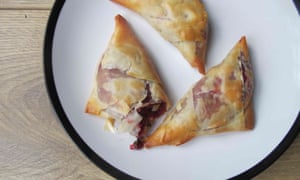
Shaping the samosas is by far the most complicated element of the whole procedure, although one that is mastered fairly quickly. Sodha recommends cutting trapeziums and Daley devotes a whole page to his method, which involves rolling a stack of pastry rounds together and then heating them to dry them out before use. Two pages may have been better for slow learners like me, because I find it impossible to separate the rounds after rolling them together – and, in any case, the whole thing seems needlessly fiddly when Jaffrey and Singh’s semi-circles, rolled into a cone shape before stuffing, work so well.
Cooking
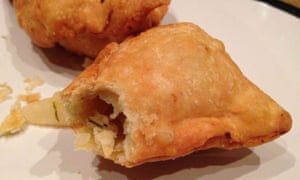
Sodha, ever the maverick, bakes her samosas for a “lighter, less oily” result. Again, it works fine (200C/390F for about 15 minutes, until golden brown), but a baked samosa will never achieve the same puffy, flaky richness as the deep-fried variety. As with the chicken kiev or the scotch egg, there really is no substitute for a pan of hot fat and some strong nerves.
Make sure the oil doesn’t get too hot, though; as Singh observes, you need to keep the heat medium-low heat otherwise the pastry shell won’t cook through before the outside burns.
The perfect samosas
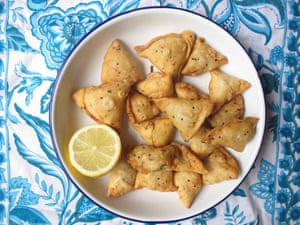
(Makes 24 mini samosas or 12 larger ones)
For the pastry
130g plain flour
¼ tsp salt
½ tsp nigella seeds (optional)
2 tbsp neutral oil, plus extra to grease
For the masala
10g cinnamon sticks
1 tsp cloves
1½ tsp cumin seeds
3-4 small dried red chillies
For the filling
1 medium potato, about 175g
1 tbsp finely grated ginger
1 small green chilli, finely chopped
1 tbsp neutral oil
½ onion, finely chopped
½ carrot, finely chopped
50g green cabbage, cored and finely shredded
40g peas
50g paneer, cut into small dice
Fine salt
Juice of ½ lemon
Small bunch of coriander, finely chopped
Neutral oil, to deep fry
To make the pastry, put the flour in a large bowl and whisk in the salt and nigella seeds, if using. Add the oil and rub in with your fingers, then gradually add just enough cold water to bring it together into a stiff dough – about 50ml should do it. Knead for about five minutes until smooth, then lightly oil, cover and set aside to rest.
Put the potato, skin on, into a small pan, cover with cold, well-salted water, bring to the boil, then simmer until tender. Drain and mash.
Meanwhile, toast the ingredients for the masala together in a hot pan until fragrant, then allow to cool and grind until you have a smooth powder. Mash the ginger and chilli together into a paste.
Heat the oil in a large frying pan over a medium heat and fry the onion until soft and golden, then stir in the carrot, turn down the heat a little and cook for five minutes, then stir in the cabbage and cook until beginning to soften. Turn up the heat to medium-high and salt the paneer well, then add to the pan along with the peas. Cook for a couple of minutes, then stir in the ginger chilli paste and half a teaspoon of the masala and cook for another couple of minutes, stirring. Stir in the potato and lemon juice and season to taste.
Divide the pastry into 12 balls of about 18g each for small samosas, or 6 balls of about 35g for slightly larger ones, and put all but one under a damp cloth. Roll the ball out on a lightly greased surface to a circle about 18cm (10cm for small) in diameter and cut in half. Pick up one half, wet the round edge with water and form into a cone shape, overlapping the wet edge and pressing together to seal.
Stir the coriander into the mixture, then fill the cones. Wet the top edge, pinch to close and fold over any remaining flap of pastry. Repeat with the remaining pastry, making sure each samosa is well sealed.
Heat a deep frying pan with about 4cm of oil to about 175C/347F, or use a fryer. When the oil has come to temperature add a batch of samosas (don’t overcrowd the pan) and cook until golden brown, turning as necessary. Scoop on to paper towels and serve immediately.
Samosas: are these the most moreish of Indian snacks – and if not, what else would you recommend with party season fast approaching? What do you like to fill them with, and does anywhere sell a decent ready-made version?
[“source-theguardian”]


